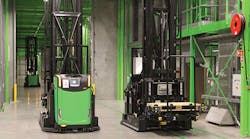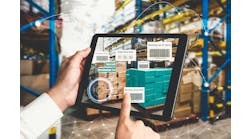The fourth industrial revolution is taking place right now. New business opportunities are arising in manufacturing and warehousing, making it all the more important to take the right actions. Automated guided vehicles (AGVs) and mobile robots are gaining ground right now and offer a way to get going in the new digitalized world. Return on investment is often less than two years and the inevitable process of change is relatively mild.
New Speed of Change
In the new industrial landscape, everything is connected and under control. The moment a customer places an order, a flood of information runs through the veins of your systems and machines. You know exactly what to produce or move, where and when. The fourth industrial revolution is the ultimate production and logistics dream come true.
The commercial world is moving faster than ever before. Today's customers can buy almost anything they want on their mobile devices, anywhere in the world, at any time of the day. As placing an order is so easy, expectations are high for fast, smooth and flexible deliveries. Staff recruitment for handling routine tasks is increasingly difficult, making the investment in automated systems for production and logistics an appropriate alternative for some companies.
The first, second and third industrial revolutions were linear. You can look upon them as steps starting with steam and water for mechanical production in the 18th century and ending with electronics and IT in the 20th century. The fourth industrial revolution is different. New ways and systems to produce and move things are evolving all the time. Velocity is key and the rate of development is exponential.
Flexibility is the Future
There is an overall need for automation to fulfill the new requirements in manufacturing and warehousing. Predicting the future is harder than ever, making flexibility necessary.
One such flexible and automated solution is AGVs. They became common in the automotive industry during the 1980s and are now found in numerous verticals, such as warehousing and retail, food and beverage, electronics, hospitals and tires.
In the AGV category you can also find new vehicle types such as carts. Mainly designed for simple driveways and small loads, they help remove work tasks with a low degree of refinement and a high degree of danger.
Make sure your AGV system is based on an open and scalable platform, ready for change in a fast-moving world. System integrations and upgrades are easier to perform when you are not locked in.
Moving People's Minds
Digitalization in industry is about boosting productivity to withstand global competition. Many governmental initiatives support the change, such as Industrie 4.0 (Germany) and Made in China 2025. The fourth industrial revolution is quickly becoming a new reality.
Before you start moving things in new ways with automated systems, you have to move people's minds. Change management is of utmost importance. Some people will be afraid of losing their jobs and will fight every attempt to change.
Others realize that automation creates new and more engaging jobs. Boston Consulting Group shows in a study that 350,000 new jobs will be created in the German manufacturing industry alone by 2025.
You need to make sure that people understand why you are making the change and what will happen when the new automated system is in place. It might take some time before everyone has learned how to work with the system, but then you have years of smooth and well-organized production and warehousing ahead of you. And if you discover even better ways to do things in the future, AGVs are flexible and allow you to adjust or redesign driveways.
Change management for AGV installations requires that you:
- Communicate the change vision—involve staff and unions.
- Empower employees—educate and define responsibilities.
- Deal with problems immediately—cut down on time for acceptance.
- Anchor best practice for AGVs—simplify for future installations.
Now is the Time
The world is moving towards total digitalization. Klaus Schwab, founder and executive chairman of World Economic Forum puts it this way: "We stand on the brink of a technological revolution that will fundamentally alter the way we live, work and relate to one another."
In our private lives we are already used to robot vacuum cleaners and the idea of self-driving cars. Now industries around the globe are getting ready to invest in automatic systems for improving production and logistics. Due to their flexibility and ready acceptance in the workplace, AGVs can allow your company a head-start in the most exciting industrial revolution ever.
Tomas Angervall is product marketing manager with Kollmorgen Automation, a provider of vehicle automation kits for automated guided vehicles (AGVs). Markus Johansson and Per Hansson of Kollmorgen Automation also contributed to this article. All photos in this article were provided by Kollmorgen.
----------------------------
A Quick Guide to AGVsMany different vehicles are capable of being automated, with size and capability depending on the industry and application. "Driverless vehicles" (i.e., cars that drive themselves) is a common term in the automotive industry. In the industrial and logistics sector, driverless vehicles have developed rapidly in recent years.
Though most often referred to as AGVs, driverless vehicles have been given various names, differing by supplier. No matter the name, the basic principle remains the same: to move things safely, efficiently and cost-effectively from point A to point B.
This quick guide will help you navigate through the latest acronyms and terms for driverless vehicles in the industrial and logistics sector.
Automated Guided Cart (AGC) is an AGV with basic functionality, designed to follow a magnetic tape and carry or draw loads. Sometimes used as a flexible alternative to conveyor systems, as you just have to move the tapes to create a new layout for the line.
Automated (or Automatic) Guided Vehicle (AGV) is a driverless vehicle that has a predictable travel route, a control system, and a customized or standardized vehicle platform. An AGV is used for routine movements of items in manufacturing, assembly and warehousing. A common AGV features a fork for lifting palletized loads, while other typical AGVs are outfitted with clamps and platforms.
Automated Guided Vehicle System (AGVS) consists of one or several AGVs that are integrated with other systems, such as WMS (warehouse management system) and ERP (enterprise resource planning).
Autonomous vehicle refers to an AGV or mobile robot equipped with an autonomous controller, allowing the vehicle to take any travel route.
Intelligent Autonomous Vehicles (IAVs) are AGVs and mobile robots that perform motion control tasks in unstructured or partially structured environments. The technology is under development, and the aim is that IAVs should be able to perform complex navigation and motion tasks in cooperation with each other, with human-operated systems, and with the surrounding environment.
Laser Guided Vehicle (LGV) means almost the same as AGV, but uses laser for navigation.
Mobile robots are small vehicles designed to move small loads. There's no need for a fixed navigation system, such as tape or reflectors, as mobile robots learn how to find their way to almost any spot in a facility. AGVs are sometimes referred to as mobile robots.
Self-driving vehicles is a collective name for numerous vehicles designed for land, air and sea applications. The category includes vehicles that could be referred to as AGVs.
Vision Guided Vehicle (VGV) is an AGV that uses objects in the existing environment for navigation, eliminating the need to install reflectors or markers.





